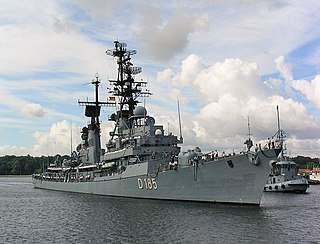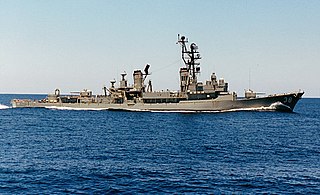
The RUR-5 ASROC is an all-weather, all sea-conditions anti-submarine missile system. Developed by the United States Navy in the 1950s, it was deployed in the 1960s, updated in the 1990s, and eventually installed on over 200 USN surface ships, specifically cruisers, destroyers, and frigates. The ASROC has been deployed on scores of warships of many other navies, including Canada, Germany, Italy, Japan, the Republic of China, Greece, Pakistan and others.

USS Long Beach (CLGN-160/CGN-160/CGN-9) was a nuclear-powered guided missile cruiser in the United States Navy and the world's first nuclear-powered surface combatant. She was the third Navy ship named after the city of Long Beach, California.

The Charles F. Adams class is a ship class of 29 guided missile destroyers (DDG) built between 1958 and 1967. Twenty-three were built for the United States Navy, three for the Royal Australian Navy, and three for the West German Bundesmarine. The design of these ships was based on that of Forrest Sherman-class destroyers, but the Charles F. Adams class were the first class designed to serve as guided missile destroyers. 19 feet (5.8 m) of length was added to the center of the design of the Forrest Sherman class to carry the ASROC launcher. The Charles F. Adams-class were the last steam turbine-powered destroyers built for the U.S. Navy. Starting with the succeeding Spruance-class, all U.S. Navy destroyers have been powered by gas turbines. Some of the U.S. Charles F. Adams class served during the blockade of Cuba in 1962 and during the Vietnam War; those of the Royal Australian Navy served during the Vietnam War and Gulf War.

The General Dynamics RIM-24 Tartar was a medium-range naval surface-to-air missile (SAM), and was among the earliest surface-to-air missiles to equip United States Navy ships. The Tartar was the third of the so-called "3 T's", the three primary SAMs the Navy fielded in the 1960s and 1970s, the others being the RIM-2 Terrier and RIM-8 Talos.

The Mark 13 guided missile launching system (GMLS) is a single-arm missile launcher designed for use on frigates and other military vessels. Because of its distinctive single-armed design, the Mark 13 is often referred to as the "one-armed bandit".

The Bendix RIM-8 Talos was a long-range naval surface-to-air missile, and was among the earliest surface-to-air missiles to equip United States Navy ships. The Talos used radar beam riding for guidance to the vicinity of its target, and semiactive radar homing (SARH) for terminal guidance. The array of four antenna which surround the nose are SARH receivers which functioned as a continuous wave interferometer. Initial thrust was provided by a solid rocket booster for launch and a Bendix ramjet for flight to the target with the warhead serving as the ramjet's compressor.

The Type 103 Lütjens class was the last class of destroyers in service with the German Navy. The ships were US Charles F. Adams-class guided missile destroyers but with some modifications to meet German requirements.

The Tartar Guided Missile Fire Control System is an air defense system developed by the United States Navy to defend warships from air attack. Since its introduction the system has been improved and sold to several United States allies.

The Perth-class destroyers were three modified Charles F. Adams-class guided missile destroyers operated by the Royal Australian Navy (RAN). Ordered from Defoe Shipbuilding Company during 1962 and 1963, HMA Ships Perth, Hobart, and Brisbane were the first guided missiled-armed warships, and the first naval ships of United States design, to enter service with the RAN. All three ships operated during the Vietnam War, while Brisbane also participated in the Gulf War. The class was decommissioned between 1999 and 2001, with all three vessels later sunk as dive wrecks.

New Threat Upgrade (NTU) was a United States Navy program to improve and modernize the capability of existing cruisers and destroyers equipped with Terrier and Tartar anti-aircraft systems, keeping them in service longer. It was a key component of then-President Ronald Reagan's 600-ship Navy plan.

The Belknap-class cruiser was a class of single-ended guided missile cruisers built for the United States Navy during the 1960s. They were originally designated as DLG frigates, but in the 1975 fleet realignment, they were reclassified as guided missile cruisers (CG).

The Albany-class guided missile cruisers were converted Baltimore and Oregon City-class heavy cruisers of the United States Navy. All original superstructure and weapons were removed and replaced under project SCB 172. The converted ships had new very high superstructures and relied heavily on aluminum to save weight.

The RIM-66 Standard MR (SM-1MR/SM-2MR) is a medium-range surface-to-air missile (SAM), with a secondary role as anti-ship missile, originally developed for the United States Navy (USN). A member of the Standard Missile family of weapons, the SM-1 was developed as a replacement for the RIM-2 Terrier and RIM-24 Tartar that were deployed in the 1950s on a variety of USN ships. The RIM-67 Standard (SM-1ER/SM-2ER) is an extended range version of this missile with a solid rocket booster stage.

The RIM-67 Standard ER (SM-1ER/SM-2ER) is an extended range surface-to-air missile (SAM) and anti ship missile originally developed for the United States Navy (USN). The RIM-67 was developed as a replacement for the RIM-8 Talos, a 1950s system deployed on a variety of USN ships, and eventually replaced the RIM-2 Terrier as well, since it was of a similar size and fitted existing Terrier launchers and magazines. The RIM-66 Standard MR was essentially the same missile without the booster stage, designed to replace the RIM-24 Tartar. The RIM-66/67 series thus became the US Navy's universal SAM system, hence the "Standard Missile" moniker.

The Harpoon is an all-weather, over-the-horizon, anti-ship missile developed and manufactured by McDonnell Douglas. The AGM-84E Standoff Land Attack Missile (SLAM) and later AGM-84H/K SLAM-ER are cruise missile variants.

The Mark 41 Vertical Launching System is a shipborne missile canister launching system which provides a rapid-fire launch capability against hostile threats. The Vertical Launch System (VLS) concept was derived from work on the Aegis Combat System.

The Mark 26 Guided Missile Launching System (GMLS) was a United States Navy fully automated system that stows, handles, and launches a variety of missiles. The system supported RIM-66 Standard, RUR-5 ASROC, and potentially other weapons. The Mark 26 had the shortest reaction time and the fastest firing rate of any comparable dual arm shipboard launching system at the time. With only one man at the control console, a weapon can be selected, hoisted to the guide arm, and launched. Several mods provided magazine capabilities of 24 to 64 missiles.















